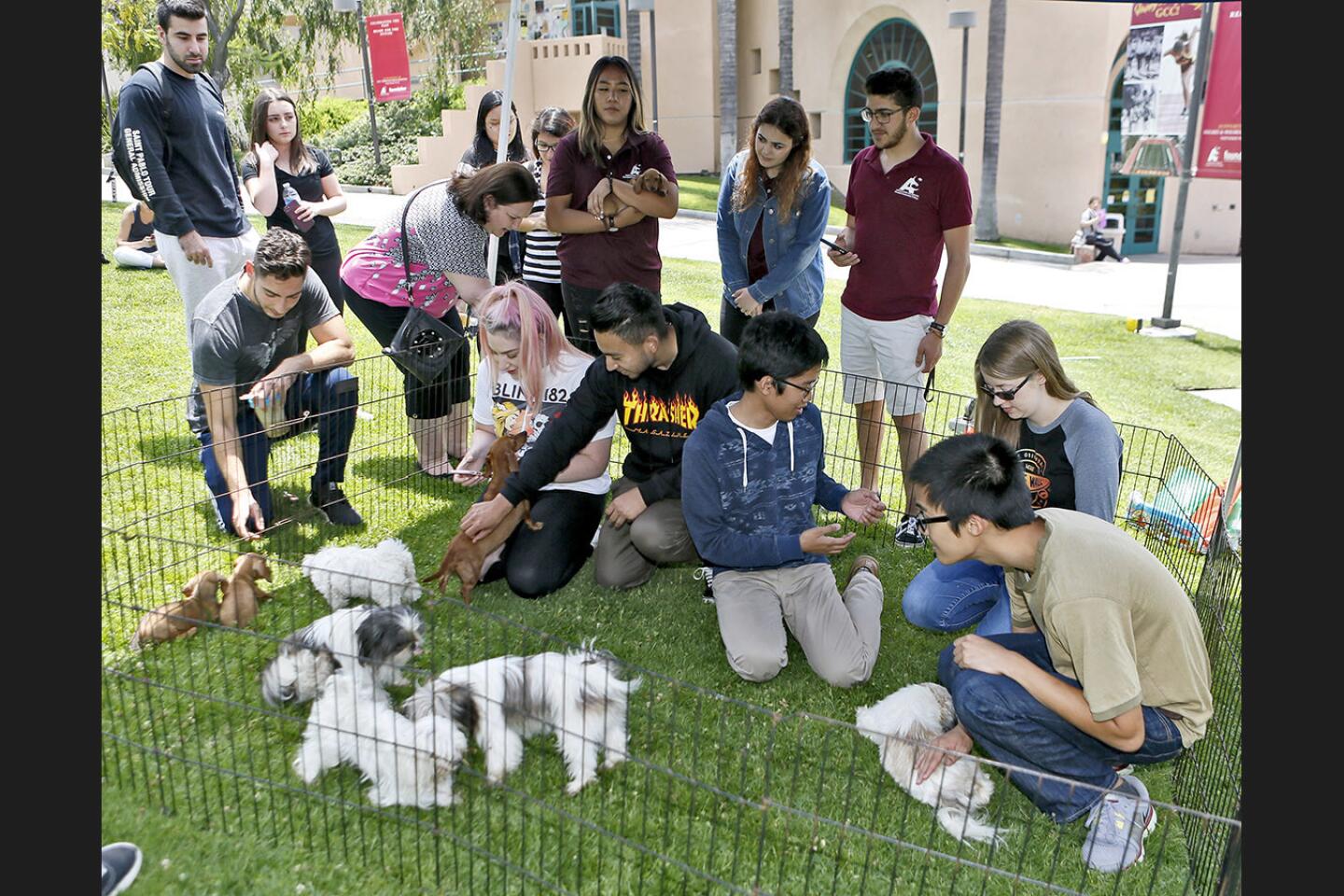California pet stores can’t sell commercially bred dogs, cats and rabbits, this bill says

Activists square off in puppy mill debate.
- Share via
Grassroots animal-rights activists appear to be winning a war against commercial pet-breeding facilities, which are often derided as puppy or kitten mills.
California will give their cause a huge boost if it becomes the first state in the nation to ban sales of such animals at pet stores.
In the last decade, more than 230 U.S. municipalities have passed bans of varying degrees on sales of dogs and cats raised at for-profit facilities. Most of those regulations have come in the last 2½ years.
More than 33 California cities have adopted these ordinances, including South Lake Tahoe in 2009, Los Angeles in 2016 and San Francisco and Sacramento this year.
Most of these rules allow stores to sell animals acquired from shelters, rescue groups and nonprofits. Many of the targeted pet stores have gone out of business or moved away.
Supporters said the bans are a local reaction to breeders, mostly located in the Midwest, who warehouse dogs and cats like livestock. They said too often, animals, especially breeding mothers, are locked in unsanitary and inhumane conditions without proper access to medicine, exercise and contact with people.
“This really started as a local movement,” said Amy Jesse, public policy coordinator for the Humane Society of the United States’ puppy mills campaign. “It was people that didn’t want in their own hometown a pet store supporting puppy mills. They didn’t want semi-trucks driving into their town filled with sick puppies anymore. So they went to their local elected officials and asked them to do something about it.”
Opponents say that criticism of breeders is overblown and that if the trend of outlawing commercial breeders continues, people won’t have access to popular breeds.
“Pet stores represent a well-regulated and reliable source for responsibly raised animals, often breeds which are not readily available nearby,” said Mike Bober, president and chief executive of the Pet Industry Joint Advisory Council, based in Washington, D.C. “We do think that consumer choice is an important part of this.”
There are roughly 10,000 commercial breeders of dogs and cats in the country, according to a California legislative analysis. Fewer than 2,000 breeding facilities are licensed by the U.S. Department of Agriculture.
If the current bill in Sacramento becomes law, these operations would no longer be allowed to sell to pet stores in California. Instead, stores would need to get their dogs, cats and rabbits only from shelters, adoption centers or animal-control agencies.
The proposal is aimed at not only discouraging abusive breeding practices, but also at promoting the adoption of shelter animals. In California, it costs taxpayers an estimated $250 million each year to pick up, house and often euthanize unwanted animals, including more than 800,000 dogs, cats and rabbits, according to the same legislative analysis.
“While animals are being bred in the Midwest, often in unsanitary conditions, we’ve got dogs and cats in animal shelters that need a good home,” said Assemblyman Patrick O’Donnell (D-Long Beach), the main author of the legislation — Assembly Bill 485.
The legislation recently sailed through the Assembly and is now in the Senate. Gov. Jerry Brown hasn’t taken a public stand on the bill, and he declined to comment for this article.
In the bill’s current wording, individuals could still buy animals through local breeders, the Internet and other private sales.
Animal-rights activists routinely distinguish between large commercial breeders and smaller operations. Hobby breeders, who often also show dogs professionally, have garnered a reputation as an acceptable, albeit pricey, source of purebred dogs.
Critics of the legislation in California have argued that it’s hard for many consumers to distinguish between such boutique operations and “backyard breeders” willing to compromise standards of care to maximize profits.
Restrictions on pet stores, they said, only boost black-market sales of desirable breeds, especially through questionable transactions on websites such as Craigslist.
“We think it will lead to abuse of the process and lead people to online sources, and that would be a bad thing,” said Bill Dombrowski, president and CEO of the California Retailers Assn.
Rather than outlawing the use of commercially bred dogs and cats, he said he would like to improve regulations for licensed breeding facilities.
Although the trade group doesn’t represent pet stores that sell commercially bred puppies or kittens, it does have members that sell pet food and various accessories, such as Petco and PetSmart.
“We don’t think it’s good public policy,” Dombrowski said. “There’s work being done, and we’re hopeful we can get some better standards adopted.”
Similar to the debate about livestock-farming conditions, foes of commercial pet breeding have said the minimum standards set by the federal government aren’t strict enough and are poorly enforced.
The USDA denies such allegations, saying that licenses are inspected about once a year — and more often for facilities that have repeatedly been out of compliance.
“While it is impossible for our inspectors to be at every facility every day, inspectors are highly trained and educated in the welfare of animals and ensure that the facilities that they inspect are in compliance,” said Tanya Espinosa, spokeswoman for the USDA Animal and Plant Health Inspection Service. “Over 95% of the breeders and dealers that are inspected are in substantial compliance with the Animal Welfare Act.”
There about 120 USDA inspectors who monitor licensed breeders, research facilities, distributors and other industry-related businesses. Those agency officials also handle a variety of other duties, including enforcing regulations for genetically modified crops and overseeing the welfare of livestock.
Federal standards require breeders to keep dogs in cages with at least 6 inches of headroom and a minimum floor space that’s based on the dog’s size.
For example, an average-sized dog of 37 inches would require a 1,849-square-inch cage. Female dogs get an additional 5% of allotted space for each of their nursing puppies. A veterinarian-approved exercise plan is mandatory unless the dog is kept in a cage that’s twice the minimum size.
Some in the industry have said breeders often surpass the government standards.
Both the American Kennel Club and the USDA have said they don’t specifically track such figures, but they do promote going above and beyond the requirements.
“Inspectors help new and existing breeders develop effective practices and procedures based on best accepted husbandry practices and the latest scientific and technological advances,” said Phil Guidry, government relations senior policy analyst for the American Kennel Club.
“Commercial breeding practices in the United States have already undergone care, operational and regulatory reforms that better ensure that dogs are maintained in humane conditions and puppies produced have substantiated source and health backgrounds,” he added.
Concerns about so-called puppy mills stretch back decades. But only in the last 10 to 20 years has the issue penetrated the wider public consciousness.
The first ban on pet stores selling commercially bred dogs and cats was enacted in Albuquerque in 2006. It wasn’t until several years later that more cities adopted similar ordinances.
The movement against commercial breeding practices began picking up significant momentum by late 2014, after celebrities such as Oprah Winfrey repeatedly spoke out on the issue and groups like the Humane Society shared on social media photos of animals allegedly abused by breeders.
“A lot of it is access to information,” said Jesse of the Humane Society. “The Internet is a huge part of that. It was no longer their word against ours. It was actually documentation of where the cute puppy in the window came from.”
Today, California has 100 or so pet stores that sell dogs and cats acquired from commercial breeders. If AB 485 passes, those businesses could be in a tough spot.
“When California passes the ban ... pet stores that sell puppies will essentially be put out of business,” said Jasmin Ramirez, manager of Escondido Pets. “Mom-and-pop shops that use incomes from their businesses to support their families will be forced to close.”
Activists said traditional pet store owners have the option of shifting their business model by renting storefront space to shelters and adoption agencies while offering pet-related merchandise.
It’s a “humane model,” said Judie Mancuso, founder and president of the Southern California nonprofit group Social Compassion in Legislation, which is sponsoring the bill.
Some merchants have embraced such an approach, but it’s far from clear whether that strategy would work financially on a large scale.
There’s one point that all parties to the pet-breeding debate agree on: California’s legislative experiment is being watched by other states nationwide.
joshua.smith@sduniontribune.com
More to Read
Inside the business of entertainment
The Wide Shot brings you news, analysis and insights on everything from streaming wars to production — and what it all means for the future.
You may occasionally receive promotional content from the Los Angeles Times.



















